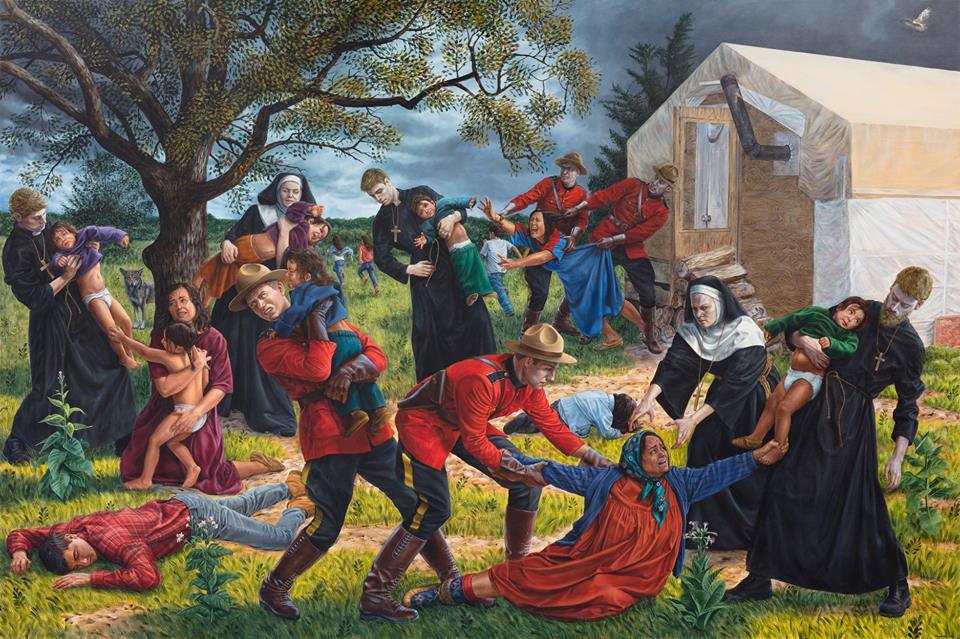
KJIPUKTUK (Halifax) – I was among a standing room only crowd at the Halifax Central Library this past Sunday afternoon to hear Kent Monkman speak about his work. If you aren’t yet familiar with Monkman, he is a Cree artist from Manitoba who redresses still commonly held European views of colonization. His work — painting, film, large installations, performance pieces — speaks to the history of Canada from the Indigenous perspective often via his alter ego, Miss Chief Eagle Testickle.
Monkman studied the old master artists, such as Italy’s Caravaggio, and “appropriated” their conventions. In doing so, he has created works so far outside of the box that it is a transformative experience to view them. His art is often humorous yet it is always executed with a critical eye to the government policies upon which Canada is based — namely those that tried to destroy the people indigenous to this land. His work can be brutal, shocking, sad, beautiful. It is enlightening and it is honest. But don’t take my word for it. His show, Shame and Prejudice, is on display at the Art Gallery of Nova Scotia until December 16. But that’s not really what I want to talk about.
After speaking for about an hour on Sunday, including screening some of his work about residential schools, the floor was opened for questions. It was probably only the 2nd or 3rd question in when a self-identified 90 year old white man (OWM) stood up. I was on the other side of the hall from him. Thus I may not have heard him precisely but the gist of his “commentary” (as opposed to a question to Mr. Monkman) was that he had taught in residential schools himself. He then went on to defend, in his words, his oblate colleagues who were “only doing what the federal government told them to do”.
This is a ridiculous argument at any time but it was particularly hard to hear following Monkman’s powerful talk and, frankly, it’s an old tired story that needs to be put to rest. OWM went on to say that it was time to move on and he guaranteed that we wouldn’t be talking about Indigenous issues in 10 years time.
I was poised to walk out rather than listen to any more of his racist pontificating when I noticed an exchange between the sign language interpreter (SLI) up front and the woman she was signing to (both black women). To me, it appeared they were having a conversation, irrespective of anything OWM was saying. Sure enough they both stopped, proceeded to walk over to OWM where the SLI told him his words were offensive and that he needed to pass the mic to someone else. I heard him say “of course I can pass it on”. I guess he did because the event continued.
I’m not sure too many of us at that point thought about the toll the exchange took on the black women who stood up, in front of everybody, to set OWM straight. Or about how the SLI was taking his insulting words into her mind and body so she could translate them into sign language. Or the care she showed for herself by stopping and saying ‘enough’. Did we wonder why the white people in the room, myself included, didn’t intervene and tell the man to sit down and shut up?
After the event, I was still in the library in the process of checking out books when I noticed the SLI talking to her white colleague who had been sharing the signing of the event with her. I stopped on my way out to acknowledge what it must have taken to confront OWM but she wasn’t having it. She lit into me about not needing my platitudes; she questioned why I hadn’t done something myself; why were white people content to just sit back in the face of, in her words, violence, and let two black women take care of business?
I’ll admit that my first thought was to defend myself but she wasn’t having that either. So I settled into my body and listened. It definitely wasn’t the most comfortable encounter for me but I knew she was right. Did she have my number? Not completely, no. Of course not. She doesn’t know me. But she knows white people. Sadly, she can’t afford not to. And as a white person, I used my privilege without even thinking I was using my privilege by opting to leave — though I didn’t because of the black women — rather than confront OWM. I didn’t even think about it. He didn’t seem worth it to me. And that’s not good enough. It troubles me that more of us don’t speak up in the public arena about racism in HRM when there’s often much discussion on the down low. What I do know is that I need to step up.
I need to pay attention to what my white skin could easily allow me to ignore. I was prepared to walk my ass out of the hall so I wouldn’t have to listen to OWM. Kent Monkman doesn’t walk away. I imagine he meets a lot of that “it’s time to move on” resistance in his travels with Miss Chief Eagle Testickle. Go see his paintings. Mic drop.
See also: Joanne Bealy: White silence
With a special thanks to our generous donors who continue to make it possible for us to publish writers such as Joanne Bealy.




I was there too, sitting closer to OWM than you. I was waiting impatiently for him to come to his point; all I could ascertain was “we were only following orders from the government.” I’m pretty slow because I didn’t actually “get” what had happened with the two black women until some time had passed. But you’re right; we need to pay attention to what our white skin could easily allow us to ignore. Thank you for pointing this out.
Something else I’d like to address is the dearth of advertising of this important show at the AGNS. I was surprised to learn at Monkman’s talk that there actually is an exhibition of his work on at the AGNS! So far, I haven’t seen or heard this publicized anywhere.
Hello Joanne. As the ‘white colleague’ in this situation I would like to provide some clarification.
In your article you say “to me, it appeared they were having a conversation, irrespective of anything OWM (Old White Man) was saying” and I am here to tell you that this is not what was taking place. This is a great assumption for someone who does not know American Sign Language and does not have an understanding of the interpreting process and profession.
Further evidence of that lack of understanding is when you say “where the SLI (Sign Language Interpreter) told him his words were offensive…” This eliminates the audience member from the action completely and erases her from the narrative. These are powerful comments made in a public article and it is our responsibility to ensure our understanding of the subject matter before we make untrue statements.
As far as your approach of my colleague and myself at the end; we were in the midst of a professional and private discussion and it was one that you invited yourself into and then did not leave regardless of clear and repeat indications that you should leave. While you stayed and took it upon to yourself to have a moment of education, you did that at the expense of my colleague and without crediting her for a lot of what were actually her words. “I’m not sure too many of us at that point thought about the toll the exchange took..” this entire paragraph was indeed information directly from my colleague and should be credited as such.
The people we harm through our actions are not in the abstract and it is disappointing to see that harm perpetuated in what is titled a ‘hard lesson on race’.
As a white person who has been surprised by the public silence among some whites on the pained history of race relations in Nova Scotia, I appreciate the commenter’s response to my piece — the headline upon which was crafted by my editor. I’m sure that there are as many interpretations of what transpired at Mr. Monkman’s excellent presentation as there were people in the standing room only crowd. I stand by my experience (as written) both during and after the presentation.
Joanne –
I was the deaf Black woman at the event, that you wrote about. Framing your story to center my – and mine alone – decision to intervene with the OWM using the services of the sign language interpreter (not signer), perpetuates the racism and ableism that is rampant in Nova Scotia, as you write about. It was my decision to stand up and cross the floor. What to you, looks like two black women intervening, was in fact me requesting communication access from the interpreter. Once she agreed, she followed me across the room and put herself in harm’s way for me to intervene and voice interpret my words into the microphone that I had taken from OWM. Those were my words, not hers. Again – choosing to approach the interpreters after the event excludes me from the dialogue. I implore you to reframe your telling of this event.